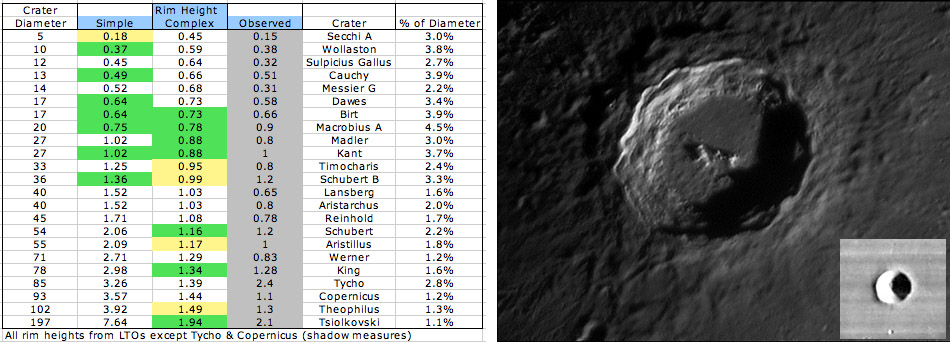Copernicus image by Oliver Pettenpaul, and Carlini image from Lunar Orbiter IV
Yesterday’s LPOD erred twice It described the rim heights of impact craters as being about 3-4% of the craters’ diameters, or for 100 km wide craters, 300-400 meters. Opps! For craters that size, peak heights should be, as a few readers noted, 3 to 4 km. But that number is wrong too, and that is the second and more interesting mistake. And therein lies a story - which is what LPOD is about. Impact craters drastically change their morphologies at diameters of 10-20 km. Small craters are generally bowl-shaped with continuously sloping interior walls and no central peaks. As their diameters increase, craters have progressively greater wall collapses (as slumps and then terraces), wider flat floors, and central peaks that become larger and more complex. These changes in morphology are reflected by changes in depths and heights. Larger craters become shallower with increasing diameters - if they didn’t, the Imbrium Basin might be 200 km deep! Crater rims also become relatively lower as diameters increase. Crater rim heights are 3-4% of crater diameters for simple craters, and decrease to 1% to 2% for larger complex craters. In the table, the rim heights in columns 2 and 3 are calculated according to least squares fits of diameters and rim heights measured for relativelly uneroded craters. There are different equations for simple and complex craters, and the colors indicate which equation best matches the measured rim heights (grey) for the listed craters. The yellowish color indicates a match within 20%, and the green, within 10%. Since these are some of the craters that were used to derive the equations the generally close agreement is expected. But note that various craters differ from the least squares fits by significant amounts, indicating that local circumstances influence rim heights. Once terraces begin to form, the original high rim slides down within the newly formed crater. This does two things - reduces rim heights and makes crater diameters greater. Hence, complex craters have lower rims than predicted from simple, unmodified craters.
Technical Details
2005-12-10 ~19:45 UT. 9.25″ Celestron + Televue 3X barlow + type II red green filter + Foculus FO124B firewire camera @15 f/s; 159/2000.
Related Links:
Both the rim heights and the equations used to derive the best fit heights come from the 1970’s work of Richard Pike, then of the US Geological Survey:
- Crater dimensions from Apollo data and supplemental sources. The Moon 15, (1976) 463-477. (online)
- Apparent depth/apparent diameter relation for lunar craters. 8th Lunar Sci. Conf., (1977), Proceedings. (Vol. 3) p. 3427-3436. (online)
Yesterday's LPOD: Rims Near the Limb
Tomorrow's LPOD: Small Spectacular
COMMENTS?
Register, Log in, and join in the comments.




